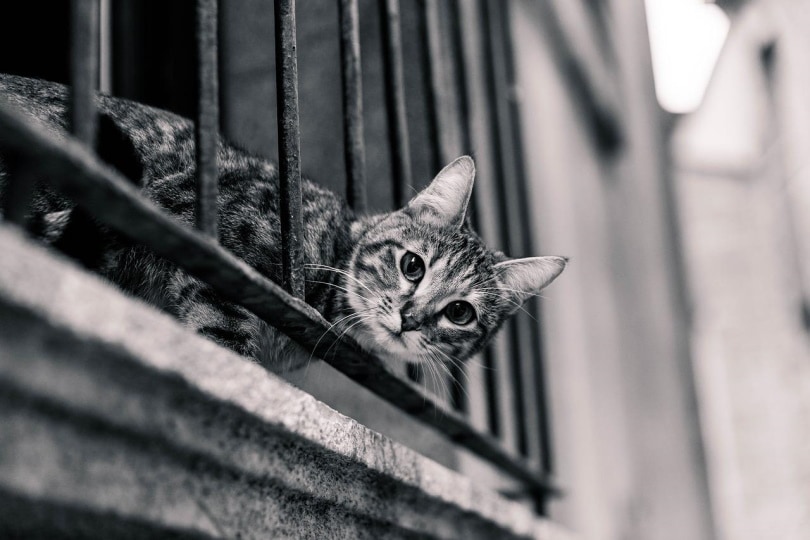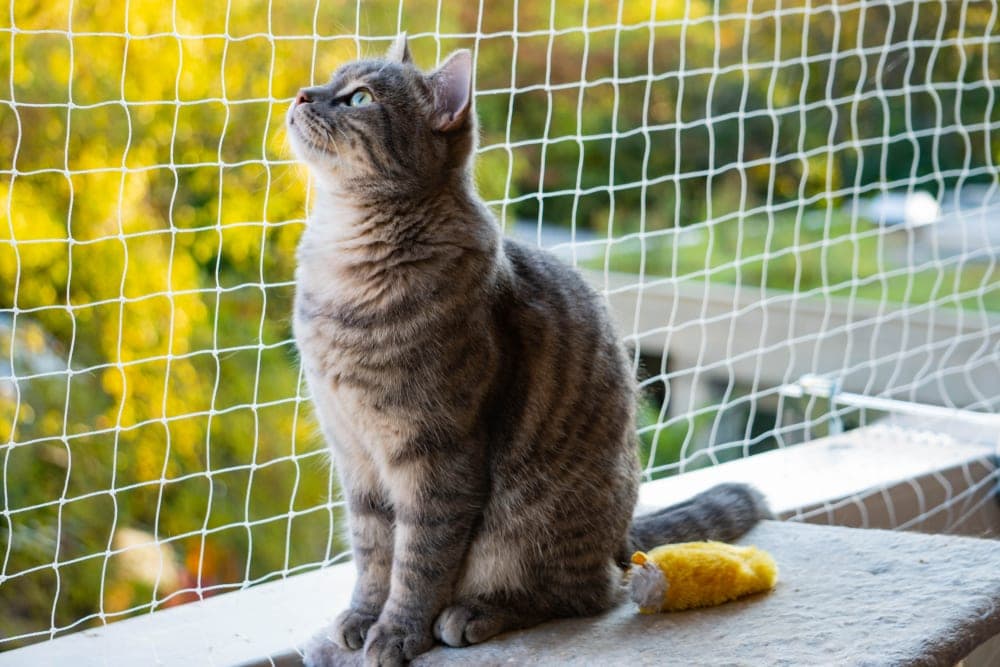
Have you ever heard the saying that if a cat falls from the Empire State Building, it will land on its feet and survive? While there is no evidence to support the saying that any cat has ever fallen from that particular building and survived, reports prove cats have fallen from heights of two stories or more and survived (but not without injury). Can you believe there are even documented cases of cats surviving falls from a 32-story skyscraper in New York City? However, it’s rare that a cat will survive a fall from this height and will likely fall to its death.
In this article, we’ll investigate high-rise syndrome and how to prevent your cat from “falling victim” to the diagnosis.
What Is High-Rise Syndrome?
High-rise syndrome refers to cats that have fallen from great heights out of a windowsill, balcony, or any other high platform and sustained injuries resulting from the fall. Cats have the ability to turn themselves right-side up when falling, which is why a cat will most likely land on its feet after a fall. Also known as a “righting reflex,” experts believe cats use vestibular and visual cues to correct their bodies to land upright.1
A 1987 study on this very topic was completed and published in the journal of the American Veterinary Medical Association.2 In the study, high-rise syndrome was diagnosed in 132 cats and was conducted over a 5-month time period. Incredibly, 90% of these cats survived over 5-story falls, but they also sustained significant injuries and would have died without prompt medical treatment. Injuries reported involved facial fractures, broken jaws, limb fractures, thoracic injuries, pulmonary contusions, shock, dental fractures, traumatic luxations, hard palate fractures, and hypothermia.
Another study conducted in 2004 examined 119 cats over a 4-year period, all diagnosed with high-rise syndrome.3 Of these 119 cats, 96.5% survived a four-story fall, again, not without significant injuries. Interestingly, these studies have shown that cats have a better chance of surviving falls from seven stories or higher due to terminal velocity, which gives a cat time to right itself and absorb some of the impact.
What Are the Signs of High-Rise Syndrome?

High-rise syndrome is not something a cat will develop due to an illness. Rather, the syndrome itself relates to the injuries a cat endures after a fall from significant heights. As we’ve mentioned, even though some cats may survive a fall from high heights doesn’t mean cats will come out unscathed. Cats will likely suffer horrific injuries due to falls from high heights, but they do have a 90% survival rate.
Even though most cats can survive a fall from significant heights, you should take precautions to keep your cat safe, which we’ll explain shortly.
What Are the Causes of High-Rise Syndrome?

Speaking of keeping your cat safe, high-rise syndrome can be prevented by taking preventative measures. People who live in high-rise apartment buildings may open a window on a beautiful spring day, but if the window has no screen, a cat can fall out. Cats also fall from balconies, tall trees, and fences. Cats that fall from high places will likely be diagnosed with high-rise syndrome, and the injuries sustained vary according to the height of the fall.
How Do I Protect My Cat From High-Rise Syndrome?
For those living in high-rise buildings, take precautions when letting your cat hang out on a windowsill. The window should be secure with a screen your cat cannot push out or tear up. Train your cat not to climb on the screen for added safety. Window enclosures or “catios” work wonderfully for this very purpose. A window enclosure or catio will allow your cat to be in the window but without the fear of your cat falling out.
Never leave your cat unattended if you have a balcony, and install safety netting or some other type of enclosure to protect your cat from falling through the railings of a balcony. Keep an eye on your cat when climbing a tree or fence. Cats are well adept at climbing trees and fences, but accidents can happen. If your cat falls, take it to the vet ASAP for an evaluation.
Frequently Asked Questions (FAQ)
Can a Kitten Survive a Two-Story Fall?
A kitten can survive a two-story fall but will most likely have injuries, resulting in being diagnosed with high-rise syndrome. However, remember that cats have a better chance of surviving a fall from a height of seven stories or more due to terminal velocity, which allows them to position themselves upright in time to absorb most of the impact. Kittens develop the instinct to exercise their “righting reflex,” but a fall from this height doesn’t allot the right amount of time to position their bodies upright.

Are Cats Safe in High-Rise Buildings?
Cats can live safely in high-rise buildings as long as you’re proactive in keeping them safe. In order to avoid high-rise syndrome, you must ensure any windows in your apartment or loft are secure. Balconies should also be secured with some form of netting or enclosure to protect your cat from falling through the railings. Cats love to be high up and explore their surroundings—they also have no fear of heights and may fall by accident.
Conclusion
Now that you know what high-rise syndrome is, you can be proactive in keeping your cat safe, especially if you live in a high-rise building. Even though cats can survive from heights as high as 32 stories, never throw your cat from a high place to see the outcome. Remember that even though cats can survive, they will still sustain significant and painful injuries from the fall. Ensure all windows are secured with a screen and check out “catios”, which allow cats to hang out on a windowsill safely and securely.
Featured Image Credit: Nils Jacobi, Shutterstock







